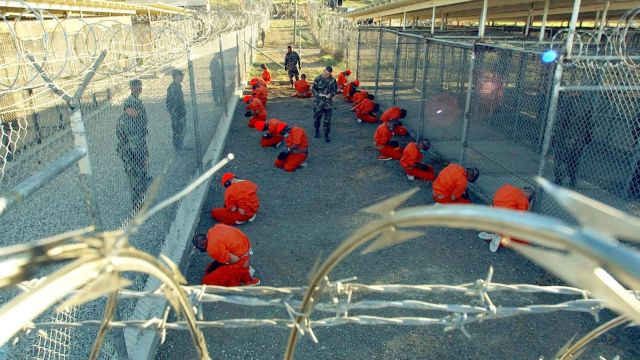Stay updated with the latest - Click here to follow us on Instagram
Guantánamo Bay prisoner released after being held for years without charge
This move is part of President Biden’s efforts to reduce the Guantánamo detainee population, which dropped from 40 prisoners at the start of his term to 26 following Yazidi’s departure.
 A Jan. 11, 2002, photo taken by Shane T. McCoy and released by the U.S. Navy shows the first 20 prisoners at Guantanamo Bay in Cuba soon after their arrival. (Petty Officer 1st Class Shane T. McCoy/U.S. Navy via The New York Times)
A Jan. 11, 2002, photo taken by Shane T. McCoy and released by the U.S. Navy shows the first 20 prisoners at Guantanamo Bay in Cuba soon after their arrival. (Petty Officer 1st Class Shane T. McCoy/U.S. Navy via The New York Times) The Pentagon has repatriated Ridah Bin Saleh al Yazidi, a 59-year-old Tunisian detainee, who was among the first prisoners brought to Guantánamo Bay when it opened on 11 January 2002. Yazidi, who was never charged with a crime, had been approved for transfer over a decade ago but remained at the prison due to failed resettlement deals, according to The New York Times.
Yazidi was transferred in a secret operation nearly a year after the US Department of Defense informed Congress of an agreement to return him to Tunisia. The Pentagon did not disclose details about the security arrangements surrounding his transfer. This move is part of President Biden’s efforts to reduce the Guantánamo detainee population, which dropped from 40 prisoners at the start of his term to 26 following Yazidi’s departure.
“Mr Yazidi’s transfer marks the fourth such operation in two weeks, as the Biden administration accelerates efforts to close the controversial prison,” The New York Times reported. Of the remaining detainees, 14 have been approved for transfer to other countries with necessary security agreements.
Yazidi was one of the first detainees photographed kneeling in the open-air compound at Camp X-Ray, an image that became symbolic of the detention operations at Guantánamo. Captured in Pakistan near the Afghanistan border in December 2001, he was initially believed to be part of a group fleeing the battle of Tora Bora. Intelligence documents suggested some members of the group were Osama bin Laden’s bodyguards, making them a priority in the US’s early search for al-Qaeda leaders.
Despite being described in a 2007 prison assessment as “hostile to guards” and a “dangerous detainee”, Yazidi was listed by an Obama-era task force in 2010 as eligible for release. Efforts to repatriate him were delayed for years due to Tunisia’s hesitation and security concerns.
Ian Moss, a former State Department official involved in prisoner transfers, said, “He could have been gone a while ago but for Tunisian foot-dragging.” Yazidi reportedly declined opportunities to be resettled in other countries.
Little is known about Yazidi’s current circumstances, including whether he has family waiting for him in Tunisia. Leaked intelligence documents claim he spent time in Italy in the 1980s and 1990s, where he was imprisoned for drug-related offences before travelling to Afghanistan in 1999 to attend a jihadist training camp. He has reportedly not seen a lawyer in nearly 20 years.
Yazidi’s repatriation comes as the prison, which once held hundreds of detainees, edges closer to closure under Biden’s administration. Only 26 detainees remain at Guantánamo, with many awaiting transfer to other nations.
- 01
- 02
- 03
- 04
- 05































